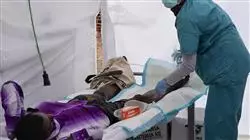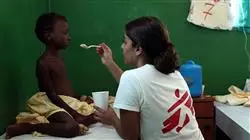University certificate
The world's largest faculty of nursing”
Introduction to the Program
With this Postgraduate diploma you will be updated on the most effective methods to work on cooperation projects and NGOs for development from Nursing"

In a world in constant transformation it is essential to continue acting through the same methods of project management. Building the capacity to work in development cooperation programs is an advantage for the nursing professional who wants to be part of this type of activity. In this sense, the study and updating are sources of the necessary knowledge for the evolved professional.
In that sense, this Postgraduate diploma in Cooperation Project Management and NGOs for Development for Nursing contains the strategic lines of work on the gender approach in International Cooperation for Development and the new frame of reference, in accordance with International Human Rights Standards.
It also includes the fundamental knowledge for the design of International Cooperation for Development projects, and thanks to the study of the 4 modules for this course, the graduate will have the criteria to evaluate the different alternatives in terms of human security and conflicts, Human Mobility and Migration, among other situations that require the attention of cooperative programs.
Therefore, in a span of 6 months, the Nurse will be able to understand the design of projects according to the Logical Framework Approach, the operation of an NGO, will have greater tools of social communication and transformation, through the study of the most complete topics and theoretical and practical material that arise in this program.
It will be a great opportunity for today’s nursing professional to update their knowledge and update on the most important cooperative processes, which will allow them to expand their horizons in the work and personal framework. Through the 100% online study of the entire curriculum chosen by a team of expert teachers, you will reach the goal easily, comfortably and safely.
After completing this program, you will work with the main vulnerable subjects involved in Development Cooperation actions and programs, in an innovative way”
This Postgraduate diploma in Cooperation Project Management and NGOs for Development for Nursing contains the most complete and up-to-date scientific program on the market. The most important features include:
- The development of case studies presented by experts in International Cooperation for the Development of the Peoples
- The graphic, schematic, and practical contents with which they are created, provide scientific and practical information on the disciplines that are essential for professional practice
- Practical exercises where the self-assessment process can be carried out to improve learning
- Its special emphasis on innovative methodologies
- Theoretical lessons, questions to the expert, debate forums on controversial topics, and individual reflection assignments
- Content that is accessible from any fixed or portable device with an Internet connection
You will delve into the system and policies of Development Cooperation in an agile and dynamic way thanks to the methodology of Relearning"
The program’s teaching staff includes professionals from the industry who contribute their work experience to this program, as well as renowned specialists from leading societies and prestigious universities.
The multimedia content, developed with the latest educational technology, will provide the professional with situated and contextual learning, i.e., a simulated environment that will provide immersive education programmed to learn in real situations.
The design of this program focuses on Problem-Based Learning, by means of which the professional must try to solve the different professional practice situations that are presented throughout the academic course. For this purpose, the students will be assisted by an innovative interactive video system created by renowned and experienced experts.
TECH, with the use of the latest educational technology, facilitates your updating of the most specialized content 100% online"

This Postgraduate diploma is designed to help you expand your knowledge in International Cooperation, contributing with quality and confidence in the decision-making process.
Why study at TECH?
TECH is the world’s largest online university. With an impressive catalog of more than 14,000 university programs available in 11 languages, it is positioned as a leader in employability, with a 99% job placement rate. In addition, it relies on an enormous faculty of more than 6,000 professors of the highest international renown.

Study at the world's largest online university and guarantee your professional success. The future starts at TECH”
The world’s best online university according to FORBES
The prestigious Forbes magazine, specialized in business and finance, has highlighted TECH as “the world's best online university” This is what they have recently stated in an article in their digital edition in which they echo the success story of this institution, “thanks to the academic offer it provides, the selection of its teaching staff, and an innovative learning method aimed at educating the professionals of the future”
A revolutionary study method, a cutting-edge faculty and a practical focus: the key to TECH's success.
The most complete study plans on the university scene
TECH offers the most complete study plans on the university scene, with syllabuses that cover fundamental concepts and, at the same time, the main scientific advances in their specific scientific areas. In addition, these programs are continuously being updated to guarantee students the academic vanguard and the most in-demand professional skills. In this way, the university's qualifications provide its graduates with a significant advantage to propel their careers to success.
TECH offers the most comprehensive and intensive study plans on the current university scene.
A world-class teaching staff
TECH's teaching staff is made up of more than 6,000 professors with the highest international recognition. Professors, researchers and top executives of multinational companies, including Isaiah Covington, performance coach of the Boston Celtics; Magda Romanska, principal investigator at Harvard MetaLAB; Ignacio Wistumba, chairman of the department of translational molecular pathology at MD Anderson Cancer Center; and D.W. Pine, creative director of TIME magazine, among others.
Internationally renowned experts, specialized in different branches of Health, Technology, Communication and Business, form part of the TECH faculty.
A unique learning method
TECH is the first university to use Relearning in all its programs. It is the best online learning methodology, accredited with international teaching quality certifications, provided by prestigious educational agencies. In addition, this disruptive educational model is complemented with the “Case Method”, thereby setting up a unique online teaching strategy. Innovative teaching resources are also implemented, including detailed videos, infographics and interactive summaries.
TECH combines Relearning and the Case Method in all its university programs to guarantee excellent theoretical and practical learning, studying whenever and wherever you want.
The world's largest online university
TECH is the world’s largest online university. We are the largest educational institution, with the best and widest online educational catalog, one hundred percent online and covering the vast majority of areas of knowledge. We offer a large selection of our own degrees and accredited online undergraduate and postgraduate degrees. In total, more than 14,000 university degrees, in eleven different languages, make us the largest educational largest in the world.
TECH has the world's most extensive catalog of academic and official programs, available in more than 11 languages.
Google Premier Partner
The American technology giant has awarded TECH the Google Google Premier Partner badge. This award, which is only available to 3% of the world's companies, highlights the efficient, flexible and tailored experience that this university provides to students. The recognition as a Google Premier Partner not only accredits the maximum rigor, performance and investment in TECH's digital infrastructures, but also places this university as one of the world's leading technology companies.
Google has positioned TECH in the top 3% of the world's most important technology companies by awarding it its Google Premier Partner badge.
The official online university of the NBA
TECH is the official online university of the NBA. Thanks to our agreement with the biggest league in basketball, we offer our students exclusive university programs, as well as a wide variety of educational resources focused on the business of the league and other areas of the sports industry. Each program is made up of a uniquely designed syllabus and features exceptional guest hosts: professionals with a distinguished sports background who will offer their expertise on the most relevant topics.
TECH has been selected by the NBA, the world's top basketball league, as its official online university.
The top-rated university by its students
Students have positioned TECH as the world's top-rated university on the main review websites, with a highest rating of 4.9 out of 5, obtained from more than 1,000 reviews. These results consolidate TECH as the benchmark university institution at an international level, reflecting the excellence and positive impact of its educational model.” reflecting the excellence and positive impact of its educational model.”
TECH is the world’s top-rated university by its students.
Leaders in employability
TECH has managed to become the leading university in employability. 99% of its students obtain jobs in the academic field they have studied, within one year of completing any of the university's programs. A similar number achieve immediate career enhancement. All this thanks to a study methodology that bases its effectiveness on the acquisition of practical skills, which are absolutely necessary for professional development.
99% of TECH graduates find a job within a year of completing their studies.
Postgraduate Diploma in Management of Cooperation Projects and NGOs for Development for Nursing
Due to the context, conflicts and needs experienced in different regions around the world, the intervention of non-governmental and non-profit organizations is of great importance. Likewise, the service of professionals to these causes is indispensable to provide help and make effective assistance in humanitarianism, human rights and guarantees for the community and the victims. In particular, the work of nurses is fundamental, since from their area of knowledge they can contribute in an integral way to the realization of a work that benefits the population. Thus, TECH Global University prepared this Postgraduate Diploma in Management of Cooperation Projects and NGOs for Development for Nursing, a course that will provide those who are interested with the latest information, tools and methodologies to specialize in international cooperation.
Become an expert in international cooperation
If one of your goals as a nursing professional is to provide a comprehensive service to ensure the safety and well-being of your patients, this program is for you. The curriculum focuses on the study of international cooperation for development, as well as the design, monitoring and evaluation of projects; social and transformative communication; and the role of NGOs in local, regional and international solidarity. In that sense, through project management and intensive study of the regions, their conflicts and main needs, you will be able to help serve the community by providing resources and benefits from the field of your profession.
Titúlate in the largest digital university in the world
At TECH Global University we have one of the largest Faculties in Nursing. Through a specialized program by the hand of experts in the area and accompanied by innovative methodologies, those who wish to take this postgraduate course will receive, in addition to theoretical-practical classes, the opportunity to learn through the study and analysis of cases based on experience and a contextualized reality. In this way, with the knowledge about the work of NGO organizations and the necessary tools for the creation, management and development of cooperation projects at your fingertips, you will become an expert, guaranteeing your personal and professional growth.







